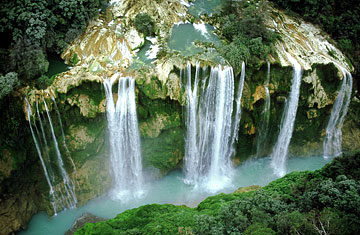
Making a splash
La Huasteca is known for its stunning waterfalls, like this one at Tamul
La Huasteca, an expansive rainforest region in central and northeastern Mexico, is not easy to reach. The adventurous make the eight-hour drive from Mexico City to the state of San Luis Potosi, where some of La Huasteca's best attractions lie. Others knock several hours off the journey time by catching a flight to the state capital (also called San Luis Potosi, or simply San Luis) and then driving over the Sierra Madre mountains. But most holidaymakers still prefer to congregate on Mexico's famous beaches, margaritas in hand.
This means that vast swaths of La Huasteca have never known a tourist and reward the persistent traveler with virgin jungle, pristine waterfalls and calm lagoons, perfect for snorkeling and swimming. Over 2,000 species of plants are found there, as are spider monkeys, jaguars and toucans. The rafting, kayaking and trekking are excellent.
Las Pozas (the Pools) are an excellent first stop and typify the region's color and extravagance. These extraordinary gardens near the mountain village of Xilitla were devised by the English surrealist poet Edward James, who worked on them from 1949 right up until his death in 1984. Giant sculptures, pagodas, moss-covered follies and staircases to nowhere sprawl over 80 acres (32 hectares). Nearby is James' former home — a truly incongruous mansion of turrets and Gothic windows rising out of the jungle. Today, it is a fabulously quirky eight-room hotel, La Posada El Castillo, tel: (52) 489 365 0038, with accommodation from just $30 a night.
The Sótano de las Golandrinas (Cave of Swallows) lies a half-hour drive north of Xilitla, and is famed for two reasons. The first is the vast cavalcade of resident birds (which are in fact swifts and green parrots, not swallows) that emerges from the cavernous blackness in a kaleidoscopic exodus lasting for several hours every morning. The second is base-jumping, which is possible because of the cave's 1,220-ft. (372 m) depth. If you're not up to flinging yourself into the cave mouth with nothing but a parachute between you and oblivion, no matter. Professional handlers will lower you a small part of the way in a harness instead.
A less challenging plunge awaits at the Tamasopo waterfalls, of which Minas Viejas is a favorite — the waters are pristine and the crowds nonexistent. More swimming can be had at Nacimiento del Río Huichihuayán (Source of the Huichihuayán River) near the village of Huichihuayán. The river seems to burst right out of the mountains, forming large pools.
Although there are modest hotels peppering La Huasteca, with scenery like this, consider taking tents and a hammock to hang in the trees. There are few better ways to immerse yourself in this untamed jungle. See huasteka.net for more.
Got an awful travel gripe? The Avenger may be able to sort it out for you.
